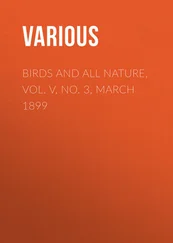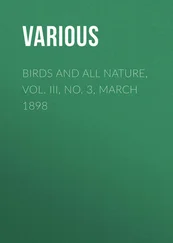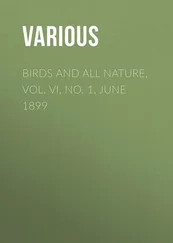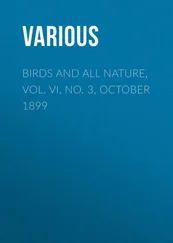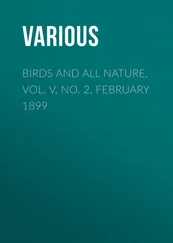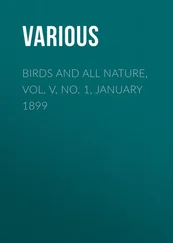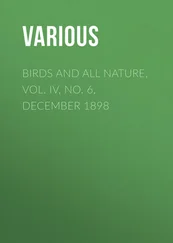Various - Birds and All Nature, Vol. V, No. 4, April 1899
Здесь есть возможность читать онлайн «Various - Birds and All Nature, Vol. V, No. 4, April 1899» — ознакомительный отрывок электронной книги совершенно бесплатно, а после прочтения отрывка купить полную версию. В некоторых случаях можно слушать аудио, скачать через торрент в формате fb2 и присутствует краткое содержание. Жанр: periodic, Биология, Природа и животные, foreign_edu, на английском языке. Описание произведения, (предисловие) а так же отзывы посетителей доступны на портале библиотеки ЛибКат.
- Название:Birds and All Nature, Vol. V, No. 4, April 1899
- Автор:
- Жанр:
- Год:неизвестен
- ISBN:нет данных
- Рейтинг книги:5 / 5. Голосов: 1
-
Избранное:Добавить в избранное
- Отзывы:
-
Ваша оценка:
- 100
- 1
- 2
- 3
- 4
- 5
Birds and All Nature, Vol. V, No. 4, April 1899: краткое содержание, описание и аннотация
Предлагаем к чтению аннотацию, описание, краткое содержание или предисловие (зависит от того, что написал сам автор книги «Birds and All Nature, Vol. V, No. 4, April 1899»). Если вы не нашли необходимую информацию о книге — напишите в комментариях, мы постараемся отыскать её.
Birds and All Nature, Vol. V, No. 4, April 1899 — читать онлайн ознакомительный отрывок
Ниже представлен текст книги, разбитый по страницам. Система сохранения места последней прочитанной страницы, позволяет с удобством читать онлайн бесплатно книгу «Birds and All Nature, Vol. V, No. 4, April 1899», без необходимости каждый раз заново искать на чём Вы остановились. Поставьте закладку, и сможете в любой момент перейти на страницу, на которой закончили чтение.
Интервал:
Закладка:
Various
Birds and All Nature, Vol. V, No. 4, April 1899 Illustrated by Color Photography
THE NUTMEG
THE nutmeg is the spice obtained from a medium-sized evergreen tree reaching a height of from twenty-five to forty feet. This tree is diœcious, that is the male flowers and the female flowers are borne upon different plants. The male flower consists of a column of from six to ten stamens enclosed by a pale yellow tubular perianth. The female flowers occur singly, in twos or threes, in the axils of the leaves; they also have a pale yellow perianth. The ovary has a single seed which finally matures into the nutmeg and mace. The mature seed is about one and one-fourth inches long and somewhat less in transverse diameter, so that it is somewhat oval in outline. It is almost entirely enveloped by a fringed scarlet covering known as arillus or arillode (mace). The entire fruit, nut, mace, and all, is about the size of a walnut and like that nut has a thick outer covering, the pericarp, which is fibrous and attains a thickness of about half an inch. At maturity the pericarp splits in halves from the top to the base or point of attachment. The leaves of the nutmeg tree are simple, entire, and comparatively large.
The English word nutmeg and the apparently wholly different German Muskatnuss , are etymologically similar. The "meg" of nutmeg is said to be derived from the old English "muge," which is from the Latin "muscus," meaning musk, in reference to the odor. "Muskat" of the German name is also derived from "muscus" and "nuss" means nut, so we have in both instances "musk nut." The arillus was named Muscatenbluome (nutmeg flower) by the early Dutch because of its bright red color.
It is generally believed that nutmeg and mace were not used in ancient times. Martius maintains that the word macis mentioned in a comedy by Plautus (260-180 B. C.) refers to mace. Flückiger, however, is inclined to believe that this word refers to the bark of some tree of India, as the word is frequently used in that sense by noted writers, as Scribonius, Largus, Dioscorides, Galenus, Plinius, and others. About 800 or 900 A. D., the Arabian physicians were familiar with nutmeg and were instrumental in introducing it into western countries. The Europeans first used nutmegs in church ceremonies as incense. Previous to 1200 nutmegs were quite expensive, but soon became cheaper as the plant was more and more extensively cultivated. About 1214 they found their way into pharmacy and began to be used among cosmetics. Hildegard described nutmegs in 1150, and Albertus Magnus (1193-1280) described the tree and fruit. Not until about 1500 did European writers learn the home of the nutmeg. Ludovico Barthema designates the island Banda as its habitat.
The Portuguese monopolized the spice trade, including nutmegs, for a time, but as stated in a previous paper, they were driven out by the Dutch, who regulated the nutmeg trade as they did the clove trade. That is, they destroyed all nutmeg trees not under the control of the government and burned all nutmegs which could not be sold. The government nutmeg plantations were in charge of army officials and worked by slaves. In 1769 the French succeeded in transplanting the nutmeg to the Isle de France. From 1796 to 1802 the spice islands were under the control of the English, who transplanted the nutmeg to Bencoolen, Penang, and, later, to Singapore. In 1860 the Singapore plantations were destroyed by a disease of the tree. The nutmeg is now cultivated in the Philippines, West Indies, South America, and other tropical islands and countries. The botanic gardens have been largely instrumental in extending nutmeg cultivation in the tropical English possessions. Besides Myristica fragrans there are several other species which are found useful. M. Otoba of the U. S. of Colombia yields an edible article known as Santa Fé nutmeg. The seeds of the tropical M. sebifera (tallow nutmeg) yield a fixed oil or fat used in making soap and candles. This oil is also known as American nutmeg oil.
The trees are produced from seeds. After sprouting the plants are transferred to pots, in which they are kept until ready for the nutmeg plantation. Transferring from the pots to the soil must be done carefully, as any considerable injury to the terminal rootlets kills the plants. A rich, loamy soil with considerable moisture is required for the favorable and rapid growth of the plants. They thrive best in river valleys, from sea-level to 300 and 400 feet or even to an elevation of 2,000 feet. The trees are usually planted twenty-five or thirty feet apart, in protected situations, so as to shelter them from strong winds and excessive sunlight.
The trees do not yield a crop until about the ninth year and continue productive for seventy or eighty years. Each tree yields on an average about ten pounds of nutmegs and about one pound of mace annually. If the trees are well cared for and the soil well fertilized, the yield is much greater, even tenfold.
As already stated the nutmeg plant is diœcious. A seed may therefore develop into a male or female plant; if a male plant it will of course not produce nutmegs. The only way to learn whether it is one or the other is to wait until the first flowers are formed during the fifth or sixth year. The planter does, however, not sit by and wait; he simply grafts the young shoots with branches of the female tree. Some male trees, about one to twenty female trees, are allowed to mature in order that pollination, by insects, may be possible, as without pollination and subsequent fertilization the seed could not develop.
The tree bears fruit all the year round, so that nutmegs may be collected at all times. It is, however, customary to collect two principal crops, one during October, November, and December, and another during April, May, and June. The nuts are picked by hand or gathered by means of long hooks and the thick pericarp removed. The red arillus is also carefully removed and flattened between blocks of wood so as to reduce the danger of breaking as much as possible. Mace and nuts are then dried separately. The nuts are placed upon hurdles for several weeks until the kernels, nutmegs, rattle inside of the thin, tasteless, and odorless hard shell. This shell is now carefully broken and removed; the worm-eaten nutmegs are thrown away and the sound ones are rolled in powdered lime and again dried for several weeks. Generally the drying is done over a smoldering fire so that the nuts are really smoke dried. For shipment they are packed in air-tight boxes which have been smoked and dusted with lime on the inside. Liming gives the nuts a peculiar mottled appearance and tends to destroy parasites which may be present.
Mace loses its carmine color upon drying and becomes reddish-brown and very brittle. It has an odor and taste similar to those of the nut, but is more delicately aromatic. Wild or Bombay mace is obtained from Myristica fatua and is frequently used to adulterate the true mace or Banda mace. The nuts of M. fatua are longer than those of M. fragrans and are therefore designated as long nutmegs; the term "male nutmegs" applied to them is incorrect. The long nutmeg is greatly inferior to the true nutmeg, or round nutmeg as it is sometimes called.
Banda supplies by far the most nutmegs at the present time. Penang nutmegs are of excellent quality and are always placed upon the market unlimed, but they are frequently limed subsequently in foreign ports and markets. Singapore nutmegs are usually unlimed. Nutmegs are generally designated by the name of the country from which they are obtained, as Dutch or Batavian, Sumatra, Penang, Singapore, Java, and Banda nutmegs.
Читать дальшеИнтервал:
Закладка:
Похожие книги на «Birds and All Nature, Vol. V, No. 4, April 1899»
Представляем Вашему вниманию похожие книги на «Birds and All Nature, Vol. V, No. 4, April 1899» списком для выбора. Мы отобрали схожую по названию и смыслу литературу в надежде предоставить читателям больше вариантов отыскать новые, интересные, ещё непрочитанные произведения.
Обсуждение, отзывы о книге «Birds and All Nature, Vol. V, No. 4, April 1899» и просто собственные мнения читателей. Оставьте ваши комментарии, напишите, что Вы думаете о произведении, его смысле или главных героях. Укажите что конкретно понравилось, а что нет, и почему Вы так считаете.


